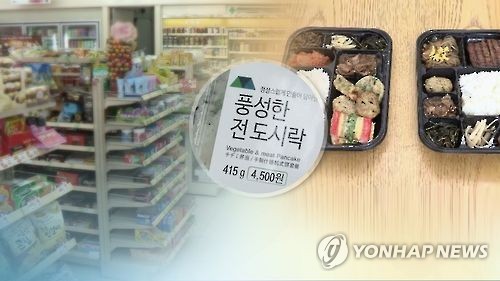Sales of boxed lunches at convenience stores are increasing at a record pace with demand growing from demographic shifts and a broadening age group of consumers, industry data showed Monday.
CU said its sales of lunch boxes increased 2.98 times as of the end of August compared with the same period last year. The jump follows a 65.8 percent increase in 2015 for the year. Helping the sales is the retail chain's collaboration with popular chef Baek Jong-won, who selected the dishes that go into the boxes. One of the lunch products replaced soju, a rice liquor, and banana-flavored milk -- the two products that had been the top-selling items for CU for 27 years -- as the No. 1 seller at the start of this year and is holding on to the ranking to date.

"Our stores have been setting new daily records in sales of lunch boxes. It's becoming hard work at production lines to keep up with the demand," a company official said.
GS25 said its sales of boxed lunches increased 2.76 times as of the end of August. A year ago, they weren't even on the top 10 best-seller list. This year, three of the lunch boxes have entered the list.
At Seven Eleven, the sales increase came to 2.54 times, with its signature lunch product placed at No. 5 among the bestsellers.
Industry watchers say the demographic changes are creating this syndrome. A national census released by Statistics Korea on Sept. 7 showed a stark increase in the number of one-person households, meaning more people eating alone. Such households, 5.2 million in all, accounted for 27.2 percent of the total.
Lunches sold at convenience stores are relatively cheap, ranging between 3,000 won ($2.66) and 4,000 won, while the quality and variety of the dishes featured in the boxes are improving.
"In the past, convenience store foods were viewed as more of on-the-go quick bites, but the lunch boxes are more like a whole meal," an official at Seven Eleven said. "The quality and taste of the lunch boxes have improved so much that they fit the preferences of workers, students and people living alone."
The customer base has become bigger with older people buying the boxed lunches, according to the watchers. In the case of CU, the age group of the buyers broke down to 31.4 percent for people in their 20s, 26.7 percent in their 30s, 19.7 percent in their 40s and 13.2 percent in their 50s. When those in their 40s and 50s are combined (32.9 percent), they outnumber customers in their 20s. In 2014, the 40-somethings and 50-somethings combined (27 percent) trailed 20-somethings (34.1 percent).
Chung, 34, is one of the office workers at a retail company in Seoul who eat boxed lunches. There are two or three other co-workers who do the same on a regular day, and they eat together.
"I use the saved time to watch TV or take a nap," she said, giving only her last name.
Convenience stores near university campuses routinely order 200 or more boxed lunches a day, a fivefold jump from last year, to serve students and faculty members during lunch hours. During the exam period, the demand grows to over 400 a day.
Nutritionists in charge of food product creations at convenience chains are concentrating on developing menus that make the lunches closer to home-cooked meals, even gourmet.
CU has included cheese cake on its menu, while GS25 launched the "chef's lunch box" that features global foods such as paella and ratatouille.
"Orders for box lunches hit a new record after the school year opened in September," said Kim Jeong-hoon, head of the quick foods team at BGF Retail, the operator of CU. "If this phenomenon continues, the market size for boxed lunches will more than double to 500 billion won this year from 200 billion won in 2014." (Yonhap)




![[Exclusive] Hyundai Mobis eyes closer ties with BYD](http://res.heraldm.com/phpwas/restmb_idxmake.php?idx=644&simg=/content/image/2024/11/25/20241125050044_0.jpg)
![[Herald Review] 'Gangnam B-Side' combines social realism with masterful suspense, performance](http://res.heraldm.com/phpwas/restmb_idxmake.php?idx=644&simg=/content/image/2024/11/25/20241125050072_0.jpg)

